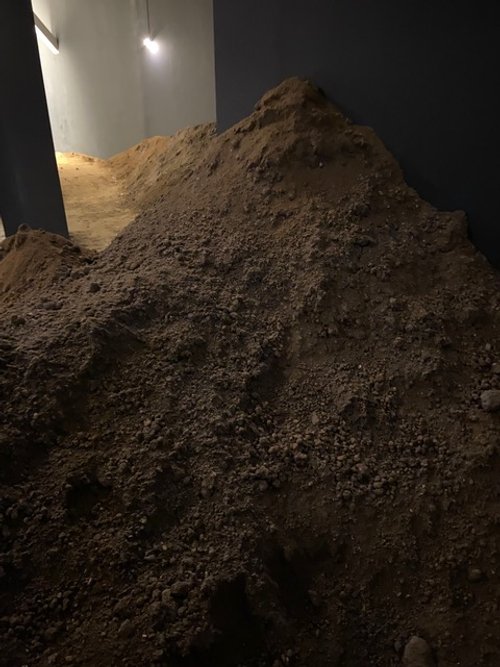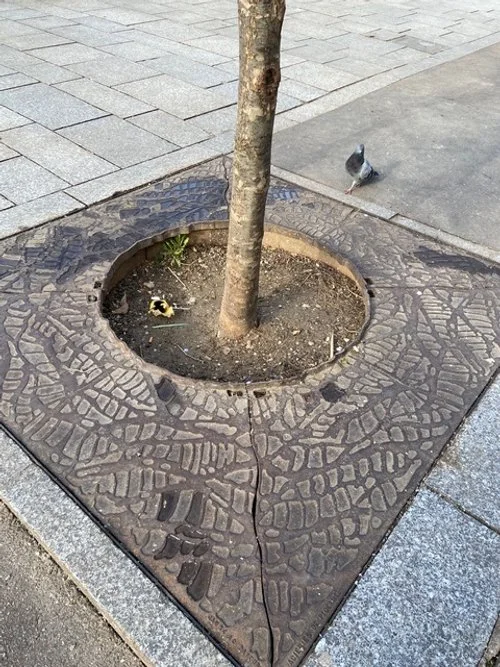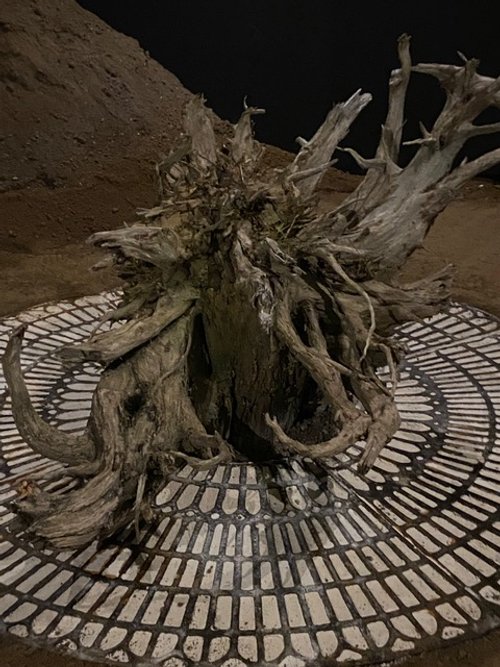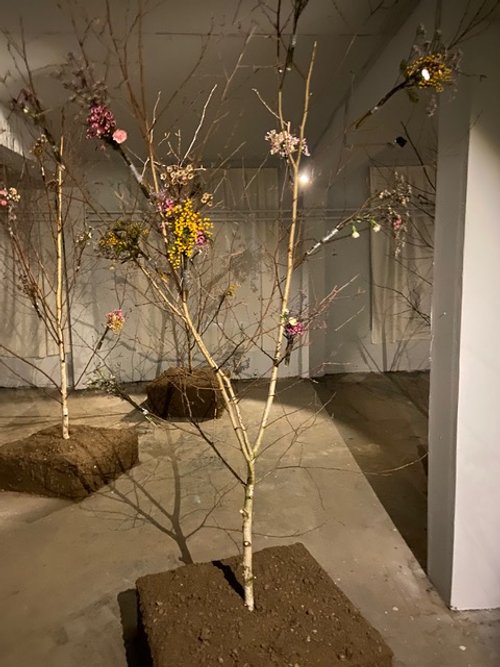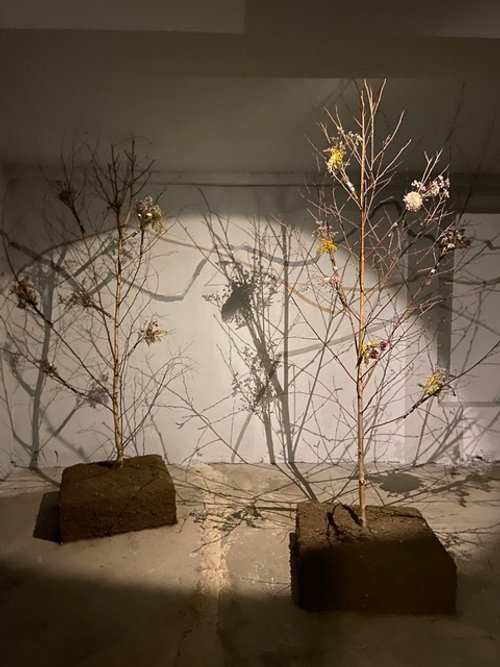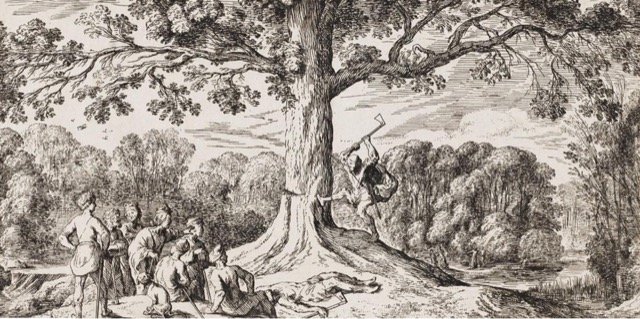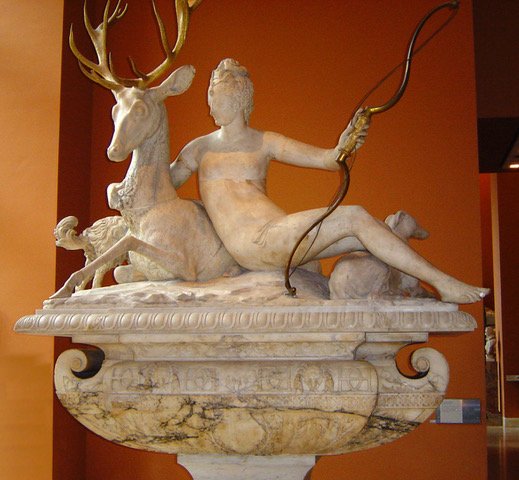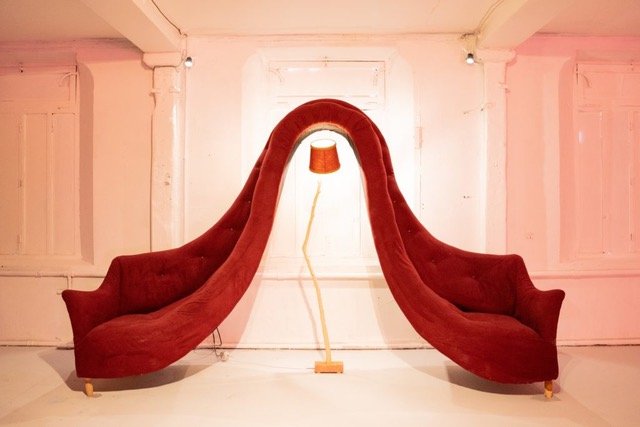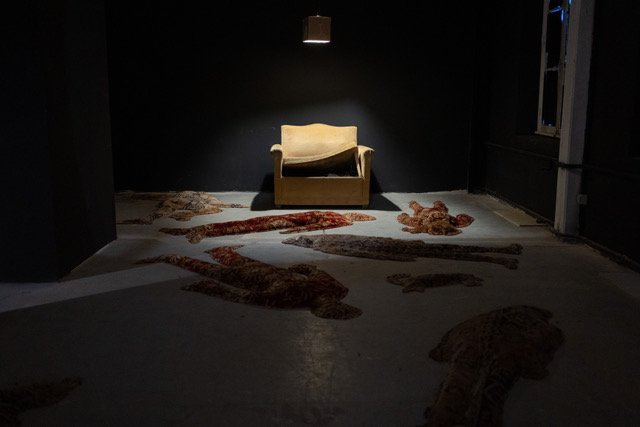Contemporary Artists: A dark and dirty future
Super Terram, Espace Voltaire
I was invited to a press opening for an exhibition. Weeks after the invitation arrived, a strike was called for the same day. For the same reason as the earlier strikes this year. French workers and wannabe workers are demonstrating against the government’s plan to raise the retirement age from 62 to 64.
I live fairly close to where the exhibition was held, which is why I was able to get there. The only metros running normally were the automated ones. For most others, only 1 in 3 cars were running. Workers were urged to télétravail (work from home) and travelers were urged to postpone their trips. When I walked back from the exhibition at 1:00 p.m. the streets were deserted. The police had diverted all traffic. It was like the first days of the pandemic. When everything shut down. It was completely, eerily empty. No cars and very few pedestrians. But the exhibition was terrific!
The curator of the exhibition invited 11 artists from around the world to show their work, in a big, abandoned, industrial space. The artists were asked to tell, in their own way, the story of how contemporary life is “disconnected from nature, (from) the spiritual, (and from) feelings”.
The curator worked with the Fondation Desperados pour l’Art Urbain, (Urban Art) whose mission is to promote urban art in all its forms by supporting emerging artists and sustaining established ones. The foundation’s parallel mission is public engagement. Desperado seems a strange name for a foundation that wants to bring street artists and the public together. It reminds me of those outlaws who terrorized the law abiding citizens of America’s Wild West, like those folks who lived in Dodge, on Gunsmoke. Maverick, anyone?
Since the Foundation has no exhibition space of its own, it presents exhibitions wherever it can. They found the space where I saw this exhibition through an organization called Plateau Urbain. And that organization exists to locate vacant urban spaces in lively places for other organizations to use.
The name of the exhibition is Super Terram, which is Latin for Above Ground. Which the gallery sheet also translated to ‘Disconnected’. The same gallery sheet explains that the exhibition will be a mysterious journey with no sure path and no clear goal. Visitors are urged to pay attention and proceed with caution, as they try to discern what is real and determine what is shadow. I was ready!
As I walked into the space the first thing I noticed was that nobody had turned on the lights. Turns out they weren’t supposed to be turned on. Gradually, my eyes adjusted and I began to notice all the dirt. (Figure 1) Piled high in some places, piled low in others. But I’m familiar with dirt and art, last year’s Venice Biennale had lots of it, tons of it in fact, both dirt and art, especially in the Arsenale (Figure 2).
Figure 1. Dirt at Super Terram exhibition
Figure 2. Dirt at the Venice Biennale, 2022
So, now that I’m here, and my eyes have adjusted, let me show you a few of the pieces I saw and introduce you to a few of the artists I met.
The first space I entered gave me a start of recognition. There were half a dozen slide projectors which reminded me of the ones I used when I taught art history. Mine were for round slide trays, called carrousels. These ones were single arm projectors with oblong side trays. (Figure 3) Nobody takes or looks at slides anymore. Even art history professors make slide presentations with images from the internet. I asked the artist where he found all the slide projectors. Same place they found the slides, at vide greniers, (garage sales). The projectors were each angled differently. Some projected images on the ceiling, some on the floor, some on the walls. According to the artist’s statement in the gallery sheet, the slides were of people at home and on vacation, in cities and in the countryside. But I couldn’t tell that, the slides were projected over tubs of water. A wave maker moved the water. The slides were transformed from images of people and places to fluid, ghostly visions. For the artist, the images are like our own fluid society where nothing is solid - not love, not friendship, not work.
Figure 3. Slide Projector with side slide tray
In another room, another artist had two pieces. One questioned the increasing domination of the artificial, the other lamented the demise of the natural. A huge QR code made of wax was set against a wall. (Figure 4) As the artist explained it, each visitor to the exhibition would stand in front of the QR code for 10 seconds and their presence would set in motion a heater that would melt the QR code which the artist hoped would be a pool of wax, on the floor, by the end of the exhibition. (Figure 5) We talked about how QR codes in France, at least since the pandemic, have come to dominate and define our lives. Each of us has an AntiCovid app on our cell phone. Before Covid restrictions were relaxed, our gauntlet for getting into a theatre or museum included opening our cell phone and showing the app to the vaccine police. The information includes name, age, address and vaccination status. We aren’t anonymous here, we can easily be traced if we want to participate in life.
Figure 4. The QR code melting (along with all of our personal information, too), Germain Ipin
Figure 5. The end of the line for the AntiCovid app, Germain Ipin
This same artist created, In another space, one of those grills that you see everywhere in Paris, in the center of which is a growing tree. (Figure 6) Here, the tree is no more, the roots which we never see, are exposed. (Figure 7) Dead now, they were once alive providing the nutrients for the tree to grow and us to breathe.
Figure 6. Trees in Paris are protected by grills like this
Figure 7. Tree from root side, the side we never see, Germain Ipin
As I went from the ground floor to the first floor, only accessible by an outdoor passage, I chatted with the young man who escorted me. He told me, apropos of nothing, that grape vines in Bordeaux, which I had always heard are strongest when their roots are forced to grow deep into the earth seeking moisture, are now growing out rather than down because the earth is contaminated.
Figure 8. ‘Vera’ in her blue crime booties and ‘moche’ (ugly) hat
Since we were going from a dirty floor place to a clean floor space, blue booties were obligatory. I sensed that my young guide was going to offer to help me put my booties on. I had a ‘Vera’ moment. You know, when Vera makes her young male assistant put the blue booties on her feet so she doesn’t contaminate the crime scene. I resisted the temptation to let him help me but I couldn’t resist asking him if he knew Vera, he did. (Figure 8) The French do. She’s the one with the moche (ugly) hat.
On the clean floor, dirt still played a role in two of the three works I saw. The first, called Endurance is a Flower, consisted of 15 or so blocks of dirt, each about one meter square in circumference and 10 cm high. In each was a bare branched tree. Affixed to some branches were small bouquets of cut flowers. (Figure 9) On the walls were shadows of the trees’ branches. There were other lines, too. The artist explained that they were migration routes. (Figure 10) The trees represent countries to which immigrants flee, hoping to build a future for themselves and their families. The bouquets represent the immigrants themselves, their beauty grafted on to barren branches. The artist told me he had been inspired to create this piece because of a woman he met in Paris, at the St. Denis market, an immigrant who told him her story, one of determination and resilience.
Figure 9. Barren trees with bouquets of flowers attached, Addam Yekutieli also Know Hope
Figure 10. Lines on wall are shadows of the tree branches and Migration Routes Addam Yekutieli 'Know Hope'
Another installation juxtaposed the Greek myth of King Erysichthon with Henri II. The piece is called Capitalize on nature / Reverse the landscape. According to the artist’s statement, this installation is meant to show how by using environments and resources for profit, we destroy the ecosystem of the communities they sustain. Erysichthon may have invented clear cutting. (Figure 11) He was punished by Demeter, the Goddess of the Harvest, for cutting down all the trees in her sacred grove to build a monumental banqueting hall. She cursed him with insatiable hunger, of which he eventually succumbed (perhaps by auto-cannibalism).
Figure 11. King Erysichthon cutting down a tree in Demeter’s Sacred Grove
The connection between Henri II who died at age 43 after a jousting match and Erysichthon wasn’t clear. Maybe the link is that all kings have oversized appetites. Maybe it’s because the artist particularly liked two sculptural groups he saw at the Louvre. One statue is of the Three Graces (Figures 12, 13) which originally supported an urn which held the heart of Henri II (until the French Revolution, that is) and a statue of Henri II’s mistress, Diane de Poitier in the guise of the Goddess Diana with her stag. (Figures 14, 15) The artist sculpted replicas of both statues in wax and intertwined bits of fabric and dirt (Figure 16) (on which mushrooms were growing, by design, the artist is also a horticulturist). They were beautiful.
Figure 12. Three Graces, Joaquín Jara, wax, fabric, dirt
Figure 13. Three Graces original French Renaissance statue, Louvre
Figure 14. The Huntress Diana and her Stag, Joaquín Jara, wax, fabric, dirt
Figure 15. Diana and her Stag, Original French Renaissance statue, Louvre
Figure 16. Three Graces, Joaquín Jara, wax, fabric, dirt, detail
There was a third statue, a lone tree trunk, (Figure 17) perhaps a more direct reference to Erysichthon and the trees he had destroyed. As we looked at the tree, the artist and I talked about another myth in which a tree figures. The myth of Apollo and Daphne. I always considered Daphne a survivor. Apollo did not rape her because as she fled his advances, she begged her father, a river god, for help. He transformed his daughter into a laurel tree. (Figures 17, 18) From then on, Apollo wore a laurel wreath. I thought, to honor the girl who got away. The artist’s take is that Apollo wears the laurel wreath because he triumphed, Daphne had to give up her human form, had to become a tree. Somehow the artist and I got on the topic of burial. Turns out we both want to be buried the same way. It was a surprising but comforting conversation.
Figure 17. Tree, Joaquín Jara
Figure 17. Apollo and Daphne, Bernini, see how her leg is becoming the bark of a laurel tree
The last installation spoke to me; beautiful art from discarded objects. During the month Michael Beitz was in Paris working on his exhibition, he collected chairs he found on the street. As he showed me, when he peeled the fabric off the seat covers, other layers were revealed. Like wallpaper, these layers connect us to the generations of people whose lives were touched by these chairs. (Figure 19) Michael is a skilled upholsterer and his craftsmanship is especially apparent in two pieces he created for the exhibition. One was a sofa distorted to fit a lamp which turned out to be just a little too tall. Precariously and humorously sofa and lamp bend to accommodate each other. (Figure 20) Another piece Michael made was of silhouettes of people he had asked to flop down on a carpet. He cut out their shapes. (Figures 21, 22) The piece is like an upholstered crime scene. From what was left of the carpet, Michael created another piece, equally beautiful. (Figure 23) His art celebrates the whimsical nature of stuff, found stuff - retrieved, refashioned and repurposed. Whimsical and beautiful.
Figure 18. Three Graces, Joaquín Jara, detail - notice how her leg is encased in soil and twigs
Figure 19. ‘Antique Organization’ Michael Beitz
Figure 20. Lamp and Sofa, Michael Beitz
Figure 21. ‘How to Imagine Japan’ Michael Beitz
Figure 22. ‘How to Imagine Japan’ Michael Beitz, Detail (the cat)
Figure 23. What was left behind, Michael Beitz
Copyright © 2023 Beverly Held, Ph.D. All rights reserved
Dear Reader, I hope you enjoyed reading this article. Please sign up below to receive more articles plus other original content from me, Dr. B. Merci!
And, if you enjoyed reading this review, please consider writing a comment. Thank you.

